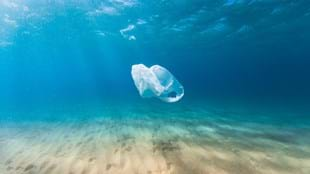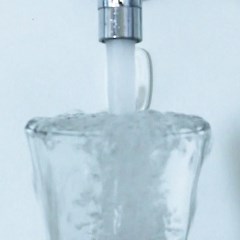Earlier this year researchers at Cambridge University and the Spanish National Research Council reported that they had identified a caterpillar, the larvae of the greater wax moth (Galleria mellonella), that can eat plastic. Specifically, the caterpillar can ingest polyethylene which, along with the closely related polypropylene, is the main type of plastic found in waste.
Good news, right? Yes, but getting rid of the amount of plastic we’re currently producing and dumping will take an awful lot of caterpillars.
Take a look at our world and how much of it is plastic. Like all those takeaway coffee cups, which environmentalists warn often contain a plastic lining that is likely to end up in landfill. Australians use an estimated one billion disposable coffee cups each year, while the UK gets through an estimated 2.5 billion.
Even though these estimates should be treated with some caution (reliable data simply isn’t collected), it’s clear we could give more thought to how we drink coffee.
Then there are the bottles, the pots, the plastic wrapped around fresh fruit and vegetables, and the plastic bags frozen fruit and vegetables come in. There are the yoghurt cartons, the dip containers, the plastic razors, the microbeads that add texture to skincare products. And all those children’s toys, and those gadgets — the buttons on your smart television, your smart television itself, the keyboard, the computer mouse … Need we go on?
OUR PLASTIC WORLD
In the 1940s, the development of plastic – a byproduct of the petroleum industry – was considered a brilliant innovation, a boon to consumer culture. We embraced it as a culture, to the extent that in the US today, plastics constitute the nation’s third largest manufacturing industry, with one million Americans working in it.
By the end of the 20th century, however, we were realizing the perils of plastic’s popularity; the very thing that makes it useful – being a resilient polymer, dense with carbon-to-carbon bonds, that is cheap to produce and isn’t easily broken down – is also why it is so environmentally problematic.
No one really knows how long plastic takes to decompose – mainly because plastics haven’t been around long enough to find out! While there are arguments about its resistance to decay, most experts agree that it lasts for a very long time – decades, possibly centuries.
Almost no plastic was produced 50 years ago, but these days it’s estimated 300 million tonnes are produced and discarded each year. The average person in North America or Western Europe goes through 100kg of plastic each year, most of it in the form of packaging.
According to Susan Freinkel, author of Plastic: A Toxic Love Story, we produced nearly as much plastic in the first decade of the 21st century as we did in the entire 20th century.
AN OCEAN OF GARBAGE
There are now virtually daily horror stories in the media about plastic debris in the oceans; wrapped around the necks or stuck in their throats of turtles due to mistaking plastic bags for jellyfish; filing the stomachs of marine mammals and birds; littering entire uninhabited islands. In 2005 plastic was discovered in the stomach of an albatross that was traced back to an airplane lost at sea in World War II – six decades earlier and 9000 kilometers away.
It’s now estimated that 10 to 20 million tonnes of plastic litter end up in our oceans each year. Most of this breaks down into progressively smaller pieces, including “microplastics” less than five millimeters across. These accumulate in so-called “garbage patches” in the sea, the most famous being the Great Pacific Garbage Patch, thought to stretch from the West Coast of North America to Japan.
Contrary to popular perception, most of the plastic in the Great Garbage Patch is made up of microscopic pieces floating beneath the surface. This is why Angelique White, Associate Professor at Oregon State University, says it is a misnomer to call it the Great Garbage Patch. “It’s not visible from space; there are no islands of trash; it is more akin to a diffuse soup of plastic floating in our oceans.” But this only makes things worse, as the plastic fragments are more likely to be eaten by oceanic creatures.
The size of garbage patches can only be determined by water sampling. Estimates of the the Great Garbage Patch vary, with some putting it at 700,000 square kilometers (270,000 square miles, or “the size of Texas”), and some at 15,000,000 square kilometers (5,800,000 square miles, or the “twice the size of the continental United States”).
According to a study by Jenna Jambeck of the University of Georgia, published in Science, 275 million metric tonnes of plastic waste were generated in 192 coastal countries in 2010, with 4.8 to 12.7 million tonnes of it ending up in the sea. The countries producing the most plastic waste were those with rapid growth and limited waste management systems, with the top 12 producers being in Asia. China was responsible for 28 percent (9m tonnes) of plastic waste, with 1.3 to 3.5m tonnes of it finding its way into the ocean. The US, which has good waste management systems, still ranked 20th. The researchers estimated that if current growth rates (and plastic consumption) continue, the total dumped into the sea in 2025 will reach 155m tonnes.
CAN WE LIVE WITHOUT PLASTIC?
Well, we have before, so yes. But clearly it will require a major philosophical and technological shift before we do so again.
Aside from the caterpillars that are partial to plastic, is there a technological fix? Some researchers are trying to develop more biodegradable forms of plastic, which breaks down into harmless molecules, or into something small enough that bacteria might want to eat. So far, however, finding a biodegradable plastic that is as strong and durable (and economically viable) as current forms, and which break down (whether exposed to sunlight or in landfills where it isn’t) have proven elusive.
Yet some minor adjustments could be made without much effort. Researchers from South Africa identified several sources of plastic found on beaches that could be made from alternative, biodegradable materials. Like earbuds which, until the 1980s, were made from rolled wax paper. Plastic straws are currently the most common litter item on South African beaches, and could also be made from waxed paper (do we really need straws anyway?). Another common item was individual sweet wrappers – wrapped around sweets that come in a packet already, and are totally unnecessary.
As the researchers note, our oceanic plastics wouldn’t be so bad if people stopped littering in the first place. But even if we dispose of plastic responsibly, assuming it will be recycled into something useful, most of it won’t be. It would be better if we used less in the first place.
Take recyclable bags to the supermarket (several countries have already banned plastic bags – lobby for the same policy where you live). Drink your coffee from cups at the café rather than order a takeaway, or take your own cup with you. Plastic keeps food fresher for longer, which means less food waste, but it is just as effective to store things in re-usable plastic containers.
In the end, consumer-driven aversion to plastic might oblige the industries using and producing it to come up with alternatives. After all, plastic was the disruptive technology of its day. Time, maybe, to disrupt again.
AT A GLANCE: THE PLASTIC CHALLENGE
- The average person in North America or Western Europe goes through 100kg of plastic each year, most of it in the form of packaging.
- In 2010, 275 million metric tonnes of plastic waste were generated in 192 coastal countries, with 4.8 to 12.7 million tonnes of it ending up in the sea.
- No one really knows how long plastic takes to decompose, if ever.
- Plastics now constitute the third largest manufacturing industry in the US, with one million Americans working in it.
- We produced nearly as much plastic in the first decade of the 21st century as we did in the entire 20th century.
- Between 10 and 20 million tonnes of plastic litter end up in our oceans each year.
- Each year coffee drinkers use an estimated 2.5 billion disposable cups in the UK alone.
- The “Great Pacific Garbage Patch” is made up of microscopic pieces of plastic floating beneath the surface, and is estimated to be up to twice the size of the continental US.
- Researchers have identified a caterpillar that can eat plastic, and others are looking for new, biodegradable forms of plastic.
- So far, finding a biodegradable plastic that is as strong and durable, and economically viable, as current forms has proven elusive.
If you want more health and fitness inspiration simply sign up to Fit Planet and get the freshest insights and advice straight to your inbox.







